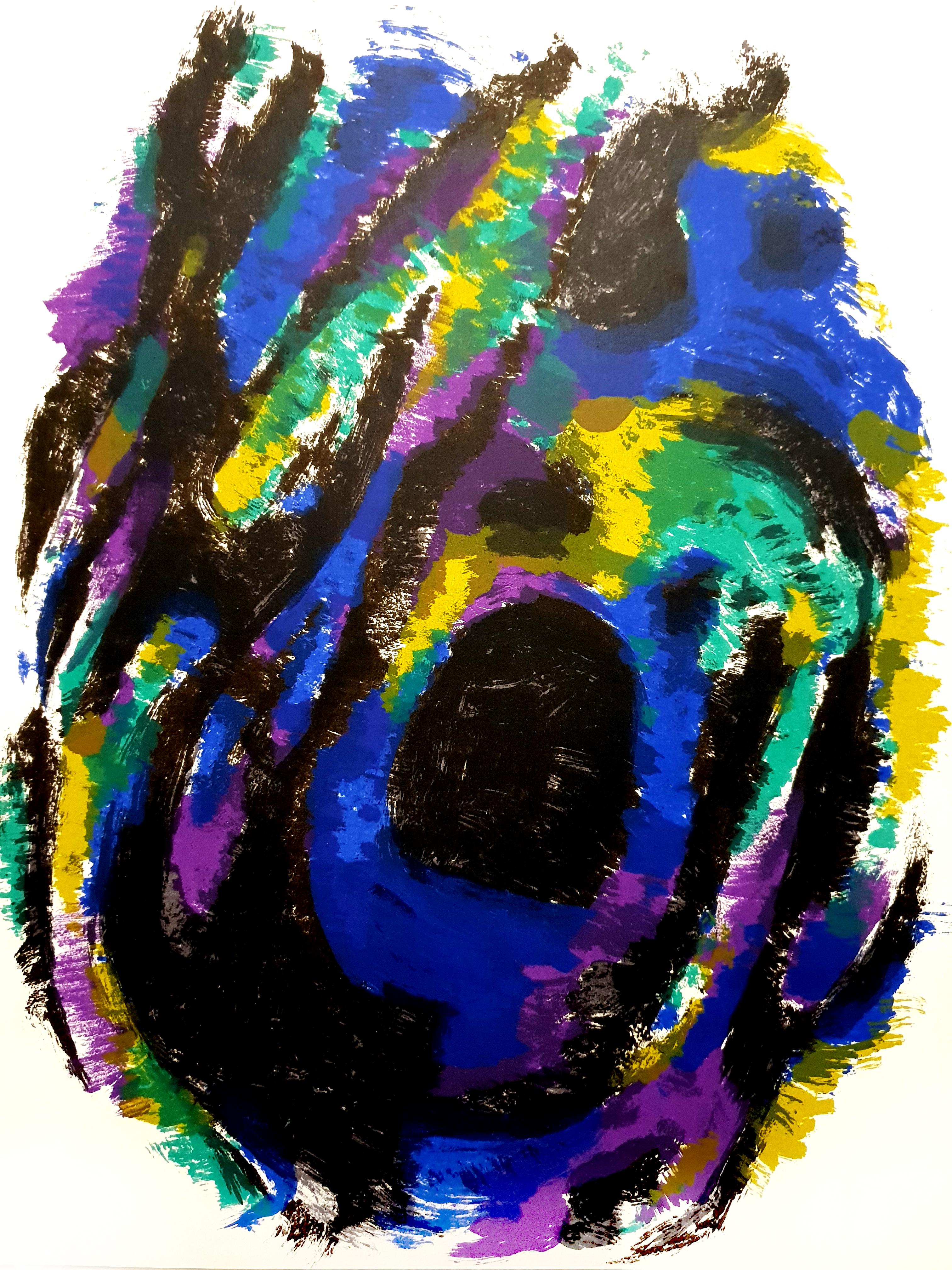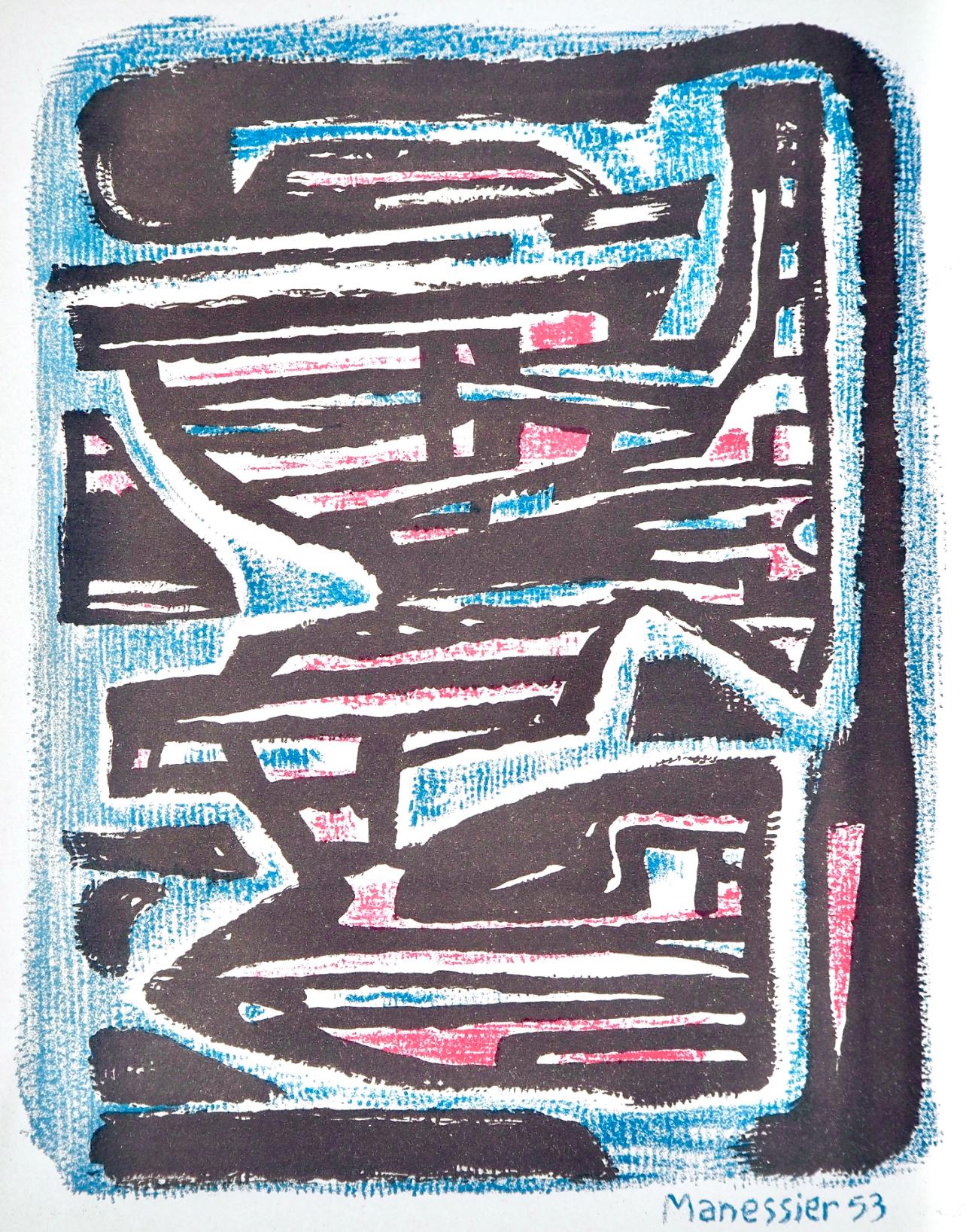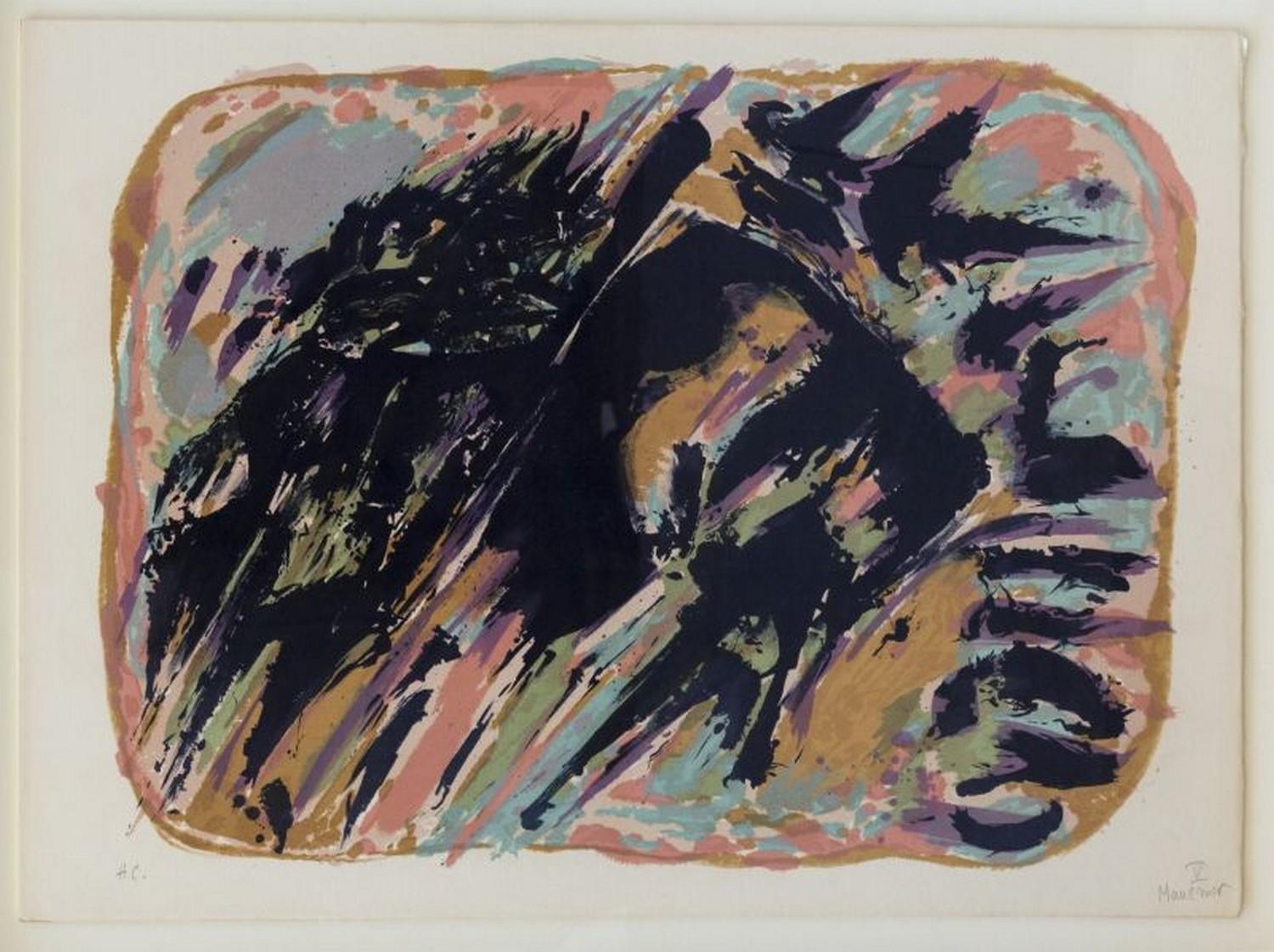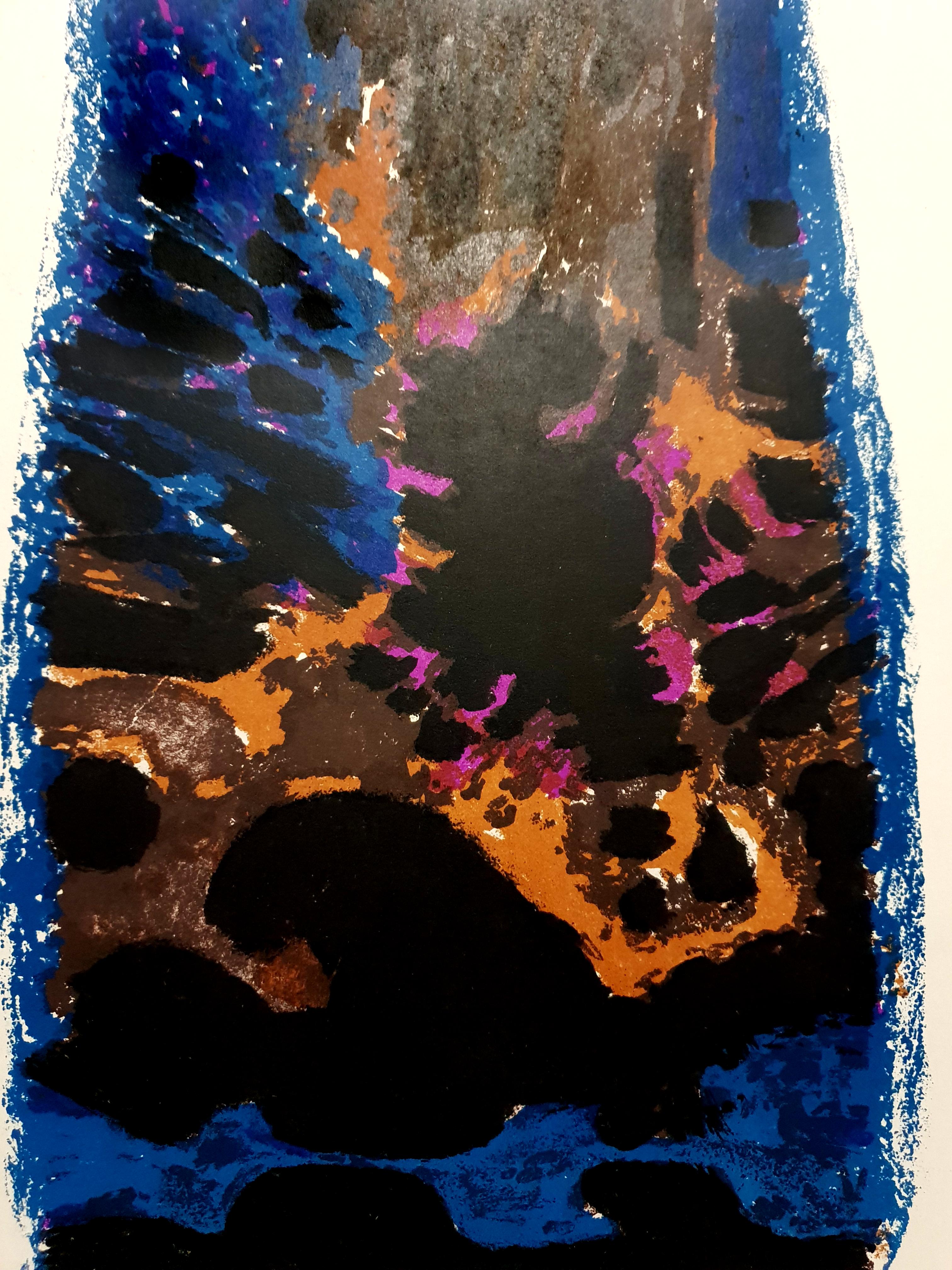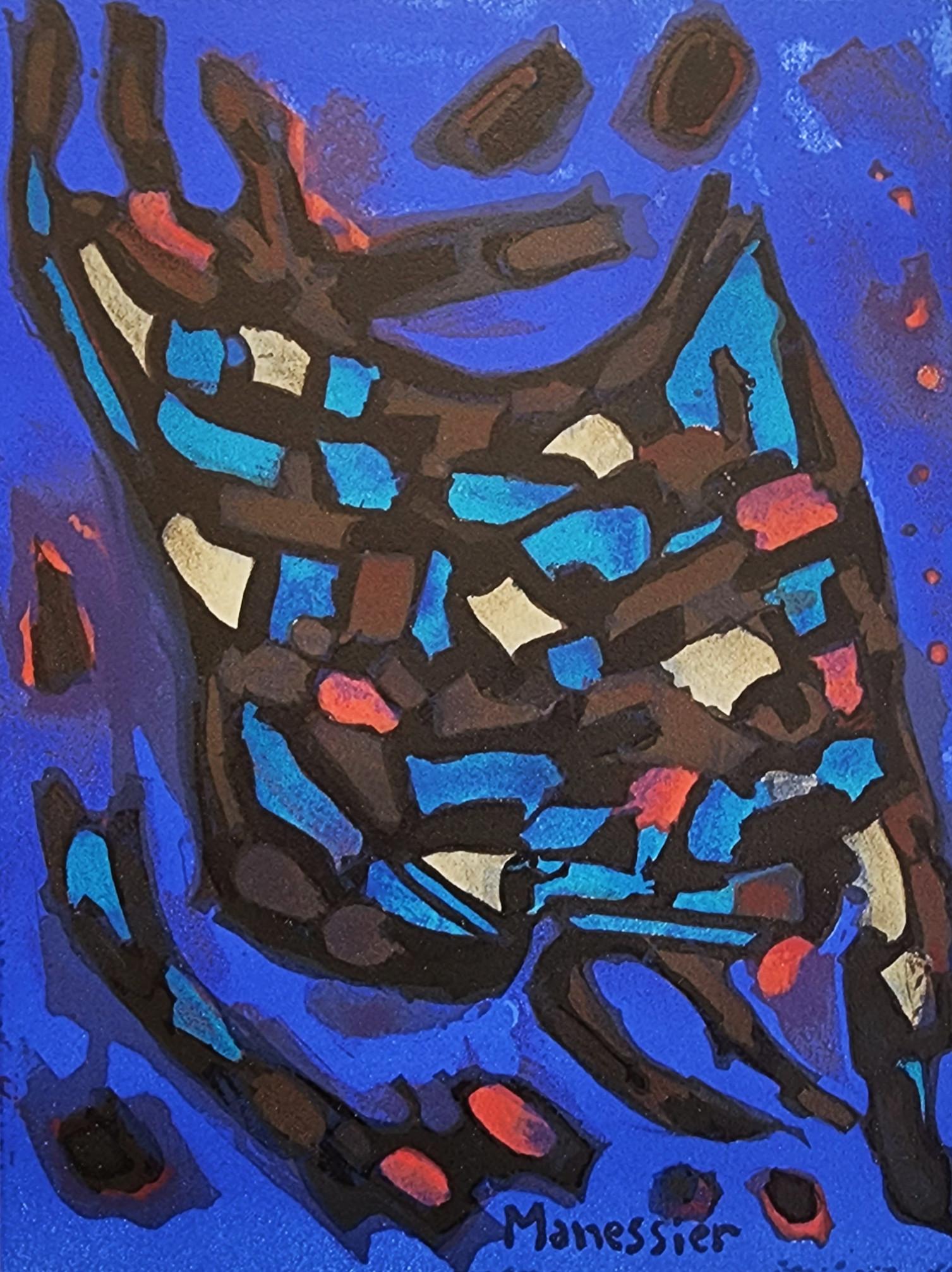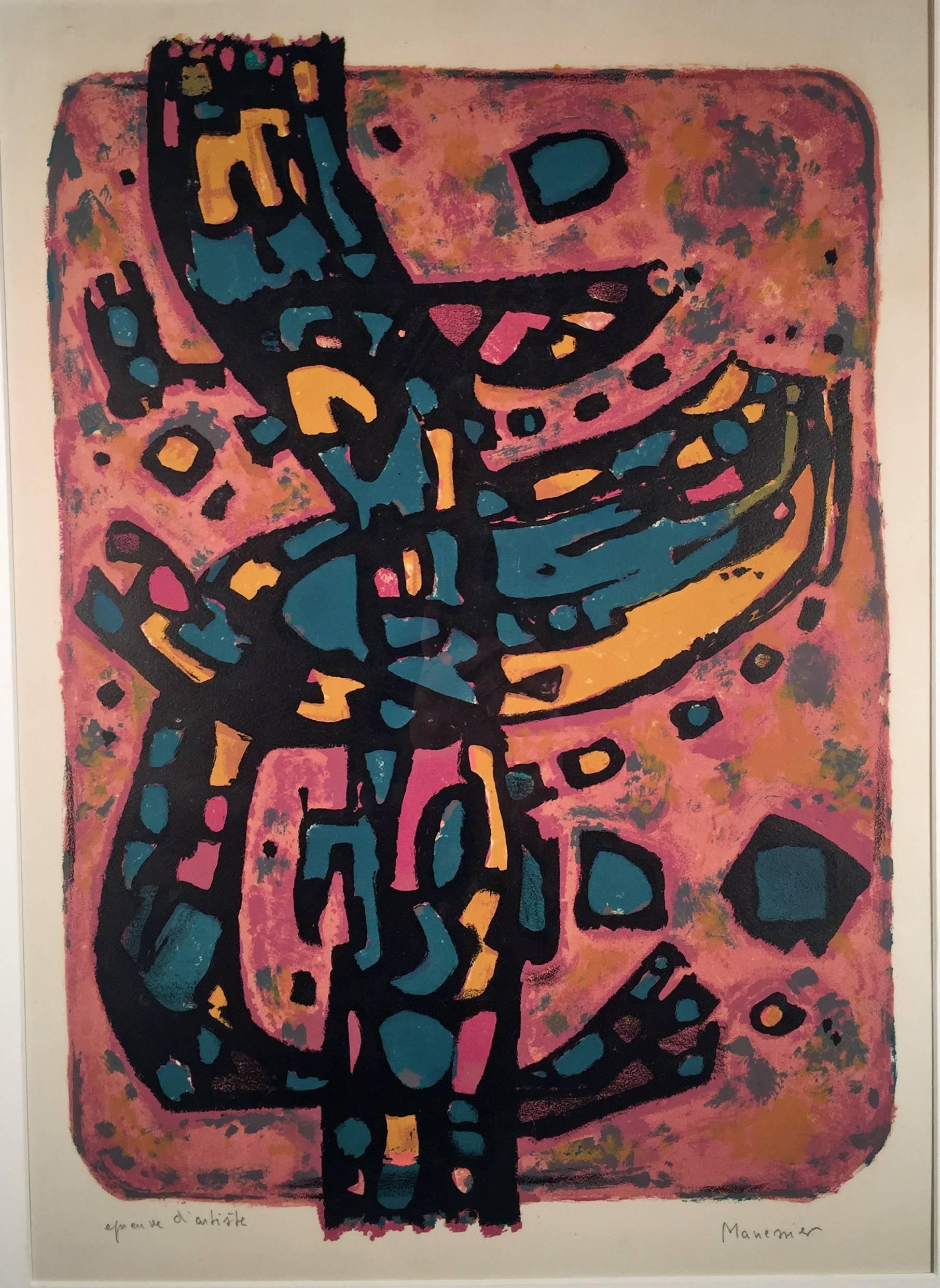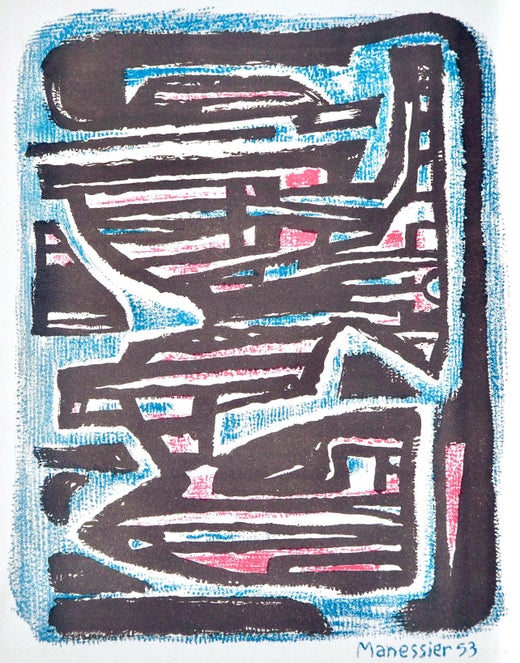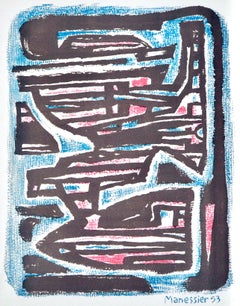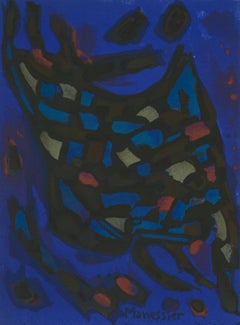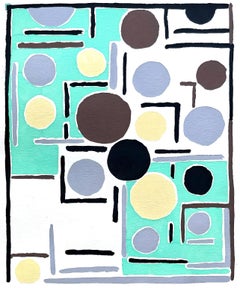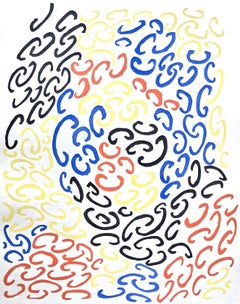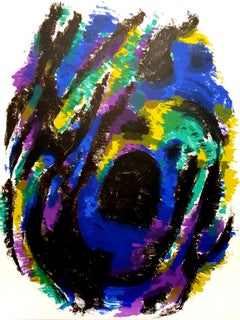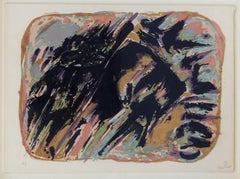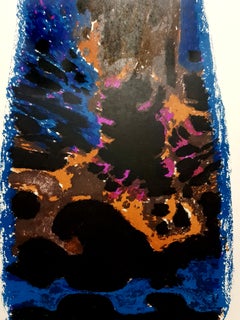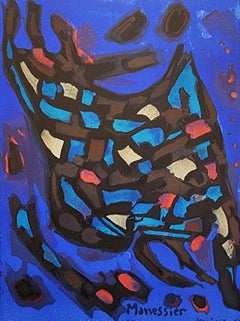Articles similaires à Le Nid, Petite tache noire n°1, Société internationale d'art XXe siècle
Vous voulez plus d'images ou de vidéos ?
Demander au vendeur plus d'images ou de vidéos
1 sur 7
Alfred ManessierLe Nid, Petite tache noire n°1, Société internationale d'art XXe siècle1960
1960
618,61 €
773,27 €20 % de remise
À propos de cet article
Lithographie sur papier vélin. Taille du papier : 12,4 x 9,65 pouces. Inscription : Non signé et non numéroté, tel que publié. Notes : Extrait de l'album, XXe siècle, Nouvelle série, XXIIe Année, N° 15, Noël 1960, Cahiers d'Art publiés sous la direction de Gualtieri di San Lazzaro, 1960. Publié par la Société Internationale d'Art XXe siècle, Paris, sous la direction de Gualtieri di San Lazzaro, éditeur, Paris ; imprimé par Mourlot Frères, Paris, 1960. Notes complémentaires : Extrait de l'article universitaire, "Promoting Original Prints, The Role of Gualtieri di San Lazzaro and XXe Siècle" par Valerie Holman, publié dans Print Quarterly, XXXIII, 2016, 2. Jusqu'à récemment, très peu d'écrits ont été consacrés à l'auteur et éditeur d'art italien Gualtieri di San Lazzaro (1904-75), Pourtant, pendant 50 ans, il a chroniqué la vie et l'œuvre d'artistes contemporains, produit des monographies d'une qualité exceptionnelle et diffusé des estampes originales de peintres et de sculpteurs modernes par le biais de son périodique le plus connu, XXe Siècle. Bien que relativement peu connu au Royaume-Uni, San Lazzaro fait partie de la demi-douzaine de grands éditeurs d'art du milieu du XXe siècle qui, avec son modèle Ambroise Vollard (1866-1939) et ceux de sa génération, Christian Zervos (1889-1970), Tériade (1889-1983) et Albert Skira (1904-73), ont choisi de s'installer à Paris, qu'ils ont considéré tout au long de leur vie comme le centre du monde de l'art.....XXe Siècle, un périodique illustré, a été lancé en 1938 et imprimé à environ 2 000 exemplaires, chaque numéro contenant à la fois des photographies et des reproductions en quadrichromie d'un large éventail d'images visuelles allant des chefs-d'œuvre de la peinture occidentale aux estampes populaires d'Extrême-Orient. Son grand format, son design vivant et l'intégration étroite du texte et de l'image ont immédiatement frappé, mais sa caractéristique la plus innovante, introduite à la suggestion de Hans Arp (1886-1966), était l'inclusion d'estampes originales d'artistes contemporains dans chaque numéro. Avec un attrait évident pour les collectionneurs, XXe Siècle a également été conçu pour faire découvrir la peinture et la sculpture contemporaines à un public plus large et international, grâce à des reproductions en couleur de bonne qualité et à l'immédiateté des estampes originales. D'un prix comparable à celui des Cahiers d'Art, les premiers numéros de XXe Siècle ont été rapidement épuisés. Bien que les préférences esthétiques de San Lazzaro tendent vers l'abstraction lyrique, il précise que XXe Siècle est non partisan [la publication a cessé pendant la Seconde Guerre mondiale]....en 1951, San Lazzaro relance XXe Siècle avec des numéros thématiques basés sur les matériaux ou centrés sur un sujet d'actualité dans les arts visuels, en particulier en Europe : les concepts d'espace, de matière, de monochromie, de marquage et de signe. En effet, alors que San Laz-zaro s'était initialement concentré sur les peintres et sculpteurs parisiens, son objectif était de créer un réseau international, de faire connaître le travail des artistes français en Italie et des artistes italiens en France, et d'étendre ensuite cet axe bilatéral au monde anglophone. Les artistes représentés dans le numéro I+I par une estampe originale étaient tous connus en tant que sculpteurs : Arp, HENRY, Henry Moore (1898-186) et Marino Marini, San Lazzaro ne cherchait pas seulement à montrer aux lecteurs l'éventail complet de l'œuvre d'un artiste, mais aussi à encourager la production d'estampes, une stimulation très appréciée, par exemple, par Magnelli..... Souffrant d'une santé défaillante, San Lazzaro perd en 1968 le contrôle global de XXe Siècle au profit de Léon Amiel, un imprimeur-éditeur qui avait apporté son soutien financier et aidé à la distribution en Amérique." Les numéros thématiques ont cessé et ont été remplacés par un "panorama" de l'année, mais San Lazzaro est toujours actif en tant qu'éditeur de livres et d'albums d'estampes....Peu de temps après sa mort, San Lazzaro lui-même a fait l'objet de deux expositions : Omaggio a XXe Siècle" à Milan en décembre 1974, centrée sur les œuvres graphiques des artistes les plus proches de lui à la fin de sa vie, tandis que "San Laz-zaro et ses Amis" au Musée d'Art Moderne de la Ville de Paris en 1975 présentait les œuvres de tous ceux dont il avait promu le travail pendant plus de 50 ans : Arp, Calder (1898-1976), Capogrossi, Chagall, Sonia Delau-nay, Dubuffet, Estève, Lucio Fontana (1899-1968), Gili-oli (1911-77), Magnelli, Marini, Miró, Moore et Poliakoff. L'un de ses plus proches collaborateurs a vu dans cette exposition un portrait indirect de San Lazzaro, un homme complexe dont la modestie et la réserve masquaient sa volonté inébranlable d'étendre l'appréciation internationale de l'art contemporain et de rapprocher le public de sa création par le biais de l'imprimé.
ALFRED MANESSIER (1911-1993) est un peintre, vitrailliste et tapissier français non figuratif, membre de la nouvelle École de Paris et du Salon de Mai. Trouvant son inspiration dans la nature de sa région natale, Manessier a commencé à peindre des paysages dès son plus jeune âge. Il étudie l'architecture, d'abord à Amiens, puis à l'École des beaux-arts de Paris en 1929. Manessier n'aime pas l'atmosphère formelle de l'école et préfère copier des tableaux au Louvre - en particulier ceux de maîtres anciens tels que Rembrandt van Rijn, Peter Paul Rubens et Tintoretto - et fréquenter les ateliers de Montparnasse. En 1935, il étudie brièvement à l'Académie Ranson avec Roger Bissière, qui l'initie à la technique de la fresque. Jusqu'à la Seconde Guerre mondiale, ses peintures commencent à refléter les influences cubistes et surréalistes. En 1939, Manessier est appelé au service militaire.
Dans l'après-guerre, Manessier est associé à l'Abstraction lyrique et à l'Art informel. Cependant, son travail s'inscrit également dans un courant plus spécifique de l'art français apparu pendant l'occupation allemande, qui intègre des thèmes et des symboles chrétiens dans des compositions semi-abstraites. Le peintre catholique Jean Bazaine, fervent défenseur de l'art sacré, a inclus les œuvres de Manessier dans la célèbre exposition Vingt jeunes peintres de tradition française (1941) organisée à la Galerie Braun, à Paris, pour défier les nazis. En 1943, Manessier connaît un réveil religieux lors d'une retraite de trois jours dans un monastère trappiste. Peu après, il se convertit au catholicisme romain et adopte un mode de vie de plus en plus ascétique. En 1945, ses compositions commencent à rappeler les vitraux et deviennent plus abstraites, bien que des éléments figuratifs liés à la religion et au paysage continuent d'apparaître. Ses peintures font allusion à des significations religieuses par leurs titres et par des combinaisons de symboles discernables et d'imagerie abstraite.
Si Gaines a d'abord été reconnu internationalement pour ses peintures, il maîtrisait une grande variété de techniques, notamment la lithographie, ainsi que la conception de tapisseries, d'objets liturgiques et d'habits sacerdotaux. À l'instigation de Georges Rouault, Manessier commence à travailler le vitrail en 1948 et réalise de nombreuses pièces pour des églises en France, en Allemagne, en Espagne et en Suisse. À partir de 1956, le symbolisme religieux et les thèmes politiques coexistent dans un certain nombre d'œuvres répondant à divers événements politiques tels que la crise de Suez, l'invasion de la Hongrie et l'assassinat de Martin Luther King Jr. Dans les années 1960, Manessier effectue plusieurs voyages en Espagne, où il est influencé par les œuvres du Greco et de Francisco de Goya, ainsi qu'au Canada, aux Pays-Bas et dans le sud de la France, où les paysages naturels - un thème récurrent dans son œuvre - influencent le contenu et le style de son travail de l'époque. En 2007, le tableau d'Alfred Manessier, Turri Davidica, a été vendu 593 217 USD à la Cornette de Saint Cyr Paris, établissant ainsi un record mondial pour l'artiste.
- Créateur:Alfred Manessier (1911 - 1993, Français)
- Année de création:1960
- Dimensions:Hauteur : 31,5 cm (12,4 po)Largeur : 24,52 cm (9,65 po)
- Support:
- Mouvement et style:
- Période:
- État:
- Adresse de la galerie:Southampton, NY
- Numéro de référence:1stDibs : LU1465216495532
Alfred Manessier
Alfred Manessier est né le 5 décembre 1911 à Saint-Ouen dans la Somme. Formé à l'Ecole des Beaux-Arts d'Amiens (1924 - 1929), il complète sa formation à l'Ecole des Beaux-Arts de Paris et effectue un bref séjour dans l'atelier du peintre Roger Bissière, qui l'initie à la fresque et auprès duquel il se réfugie à Boissiérettes dans le Lot au début de la guerre. À partir de 1947, le vitrail occupe une grande partie de son œuvre, désormais basée sur l'abstraction. Il réalise une vingtaine de projets en France, dont les vitraux de l'église Saint-Michel des Bréseux (Doubs), sa première commande (1948 - 1950), ceux de l'église Saint-Pierre de Trinquetaille à Arles (1953), et de la chapelle Sainte-Thérèse de l'Enfant Jésus et de la Sainte Face à Michele (Nord - 1957). Les vitraux de l'église du Saint-Sépulcre à Abbeville, l'une de ses dernières commandes réalisée entre 1982 et 1993, sont considérés comme son chef-d'œuvre. Il a également réalisé une douzaine de projets de vitraux en Suisse, en Allemagne et en Espagne. Peintre abstrait de l'Ecole de Paris, Manessier aborde fréquemment des sujets liés à la religion catholique. Ses peintures sont souvent inspirées par les paysages du nord de la France, mais aussi par ses voyages. À partir de 1956, il réalise un grand nombre de peintures politiques intitulées "Hommage", qui font écho à la violence du monde. La diffusion de ses œuvres dans l'espace public à travers ces vitraux lui a donné une grande notoriété de son vivant, et ses peintures ont été récompensées par de nombreux prix internationaux (comme le Grand Prix de la Biennale de Venise, qu'il a reçu en 1962, aux côtés d'Albert Giacometti, qui a reçu le Grand Prix de sculpture). Il est décédé le 1er août 1993 des suites d'un accident de voiture, peu après l'achèvement des vitraux d'Abbeville.
À propos du vendeur
4,9
Vendeur Platine
Vendeurs premium dont la note est supérieure à 4,7 et le délai de réponse de 24 heures maximum
Établi en 1978
Vendeur 1stDibs depuis 2021
1 189 ventes sur 1stDibs
Temps de réponse habituel : <1 heure
- ExpéditionRecherche du devis...Expédition depuis : Southampton, NY
- Politique des retours
Certaines parties de cette page ont été traduites automatiquement. 1stDibs ne garantit pas l'exactitude des traductions. L'anglais est la langue par défaut de ce site web.
Garantie d'authenticité
Bien qu'il soit peu probable que la situation se présente, dans le cas où vous rencontreriez un problème d'authenticité d'un article, contactez-nous dans un délai d'un an pour obtenir un remboursement intégral. DétailsGarantie de remboursement
Si votre article n'est pas conforme à la description, est endommagé pendant le transport ou ne vous est pas livré, contactez-nous sous 7 jours pour obtenir un remboursement intégral. DétailsAnnulation sous 24 heures
Vous disposez d'un délai de 24 heures pour annuler votre achat sans motif.Des vendeurs professionnels agréés
Nos vendeurs de renommée mondiale doivent respecter des normes strictes en matière de service et de qualité, afin de préserver l'intégrité de nos fiches produit.Garantie d'alignement des prix
Si vous constatez qu'un autre vendeur a mis en vente le même article à un prix inférieur sur un autre site, nous nous alignerons sur ce prix.Livraison en toute confiance à l'international
Notre réseau de transporteurs de premier ordre propose des options d'expédition spécialisées dans le monde entier, y compris des livraisons personnalisées.Plus d'articles de ce vendeur
Tout afficherComposition, Société internationale d'art XXe siècle
Par Alfred Manessier
Lithographie sur papier vélin. Taille du papier : 12,4 x 9,65 pouces. Inscription : Signé dans la plaque et non numéroté, tel que publié. Notes : Extrait de l'album, XXe siècle, Nouv...
Catégorie
années 1950, Moderne, Estampes - Abstrait
Matériaux
Lithographie
687 € Prix de vente
20 % de remise
Livraison gratuite
Manessier, Composition, Prints from the Mourlot Press (d'après)
Par Alfred Manessier
Lithographie sur papier vélin d'Arches. Non signé et non numéroté, tel que publié. Bon état. Notes : Extrait de l'album, Impressions de la presse Mourlot, 1964. Publié par Fernand M...
Catégorie
années 1960, Moderne, Estampes - Abstrait
Matériaux
Lithographie
618 € Prix de vente
40 % de remise
Livraison gratuite
Delaunay, Planche No. 15, Compositions, couleurs, idées : Sonia Delaunay (d'après)
Par Sonia Delaunay
Pochoir de couleur avec des encres gouaches denses sur papier vélin. Non signé et non numéroté, avec titre imprimé dessiné par Delaunay, en haut à gauche, tel qu'il a été publié. Bon...
Catégorie
années 1930, Moderne, Estampes - Abstrait
Matériaux
Pochoir
1 240 € Prix de vente
20 % de remise
Livraison gratuite
Delaunay, Planche No. 10, Compositions, couleurs, idées : Sonia Delaunay (d'après)
Par Sonia Delaunay
Pochoir de couleur avec des encres gouaches denses sur papier vélin. Non signé et non numéroté, avec titre imprimé dessiné par Delaunay, en haut à gauche, tel qu'il a été publié. Bon...
Catégorie
années 1930, Moderne, Estampes - Abstrait
Matériaux
Pochoir
1 240 € Prix de vente
20 % de remise
Livraison gratuite
Composition 66 (Abadie 66), Société internationale d'art XXe siècle
Par Alberto Magnelli
Linogravure sur papier vélin. Taille du papier : 12,4 x 9,65 pouces. Inscription : Non signé et non numéroté, tel que publié. Catalogue raisonné des références : Magnelli, Alberto, e...
Catégorie
années 1930, Moderne, Estampes - Abstrait
Matériaux
Linogravure
618 € Prix de vente
20 % de remise
Livraison gratuite
Delaunay, Planche No. 33, Compositions, couleurs, idées : Sonia Delaunay (d'après)
Par Sonia Delaunay
Pochoir de couleur avec des encres gouaches denses sur papier vélin. Non signé et non numéroté, avec titre imprimé dessiné par Delaunay, en haut à gauche, tel qu'il a été publié. Bon...
Catégorie
années 1930, Moderne, Estampes - Abstrait
Matériaux
Pochoir
1 240 € Prix de vente
20 % de remise
Livraison gratuite
Suggestions
Alfred Manessier - Lithographie originale
Par Alfred Manessier
Alfred Manessier - Lithographie originale
Abstraction colorée
1962
Du XXe Siecle
Dimensions : 32 x 24
Édition : G. di San Lazzaro.
Non signé et non numéroté tel qu'il a été émis
Catégorie
années 1960, Moderne, Estampes - Figuratif
Matériaux
Lithographie
Composition abstraite
Par Alfred Manessier
Lithographie, 1975
Edition : V/XV
56.00 cm. x 76.00 cm. 22.05 in. x 29.92 in. (papier)
50.00 cm. x 67.00 cm. 19.69 in. x 26.38 in. (image)
Lithographie appartenant à une série de 1...
Catégorie
années 1970, Abstrait, Estampes - Abstrait
Matériaux
Lithographie
Alfred Manessier - Lithographie
Par Alfred Manessier
Alfred Manessier - Lithographie
1962
Extrait du périodique d'art XXe siècle (n°20)
Dimensions : 32 x 24
Edition : G. di San Lazzaro.
Non signé et non numéroté tel que publié
Catégorie
années 1960, Moderne, Estampes - Figuratif
Matériaux
Lithographie
Composition (Mourlot, Paris)
Par Alfred Manessier
Alfred Manessier
Composition
1964
Lithographie couleur originale sur Velin d'Arches
Taille : 10x7.375in
Edition : 2,000
Signé dans la pierre
Verso annoté
Éditeur : Mourlot, Paris
Imp...
Catégorie
années 1960, Moderne, Estampes et éditions
Matériaux
Vélin, Lithographie
Prix sur demande
FLAMME VIVE
Par Alfred Manessier
Manessier, Alfred. FLAMME VIVE. Lithographie en couleurs, 1959. Épreuve d'artiste en plus de l'édition de 175. Inscrit "Epreuve d'Artiste" et signé au crayon. 20 x 13 1/2 pouces, 514...
Catégorie
Milieu du XXe siècle, Abstrait, Estampes - Abstrait
Matériaux
Lithographie
604 € Prix de vente
20 % de remise
Laudes II
Par Alfred Manessier
Lithographie, 1976
Signé par l'artiste au crayon.
Preuve d'artiste
Imprimeur : Mourlot, Paris
65,50 cm. x 60,50 cm. 25.79 in. x 23.82 in. (papier)
57,00 cm. x 49,00 cm. 22.44 in...
Catégorie
années 1970, Abstrait, Estampes - Abstrait
Matériaux
Lithographie
